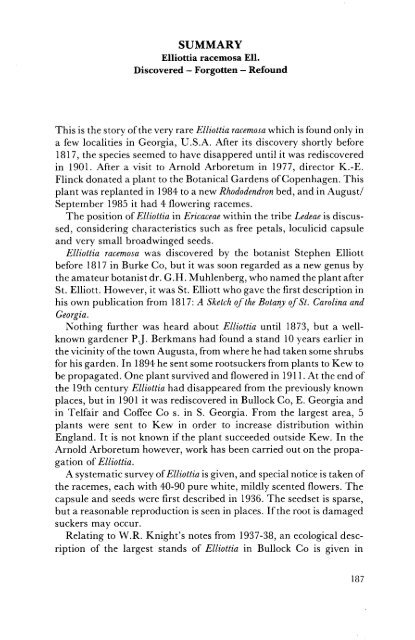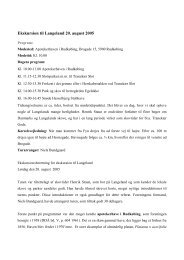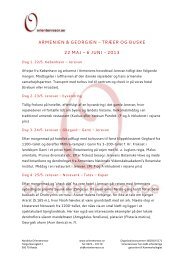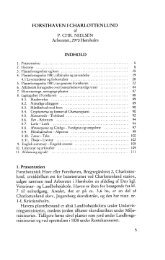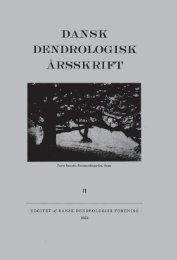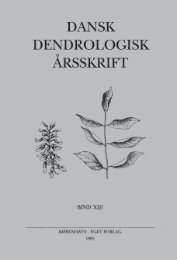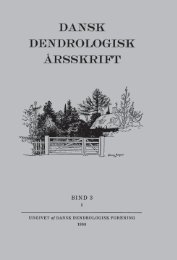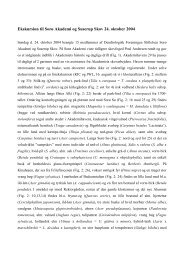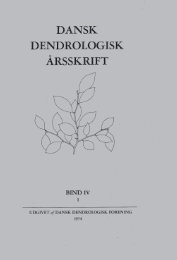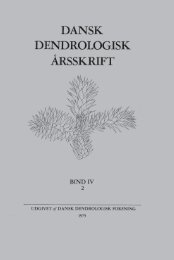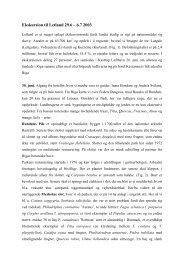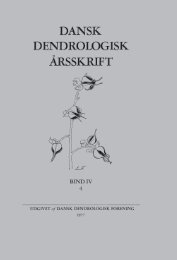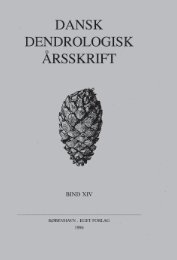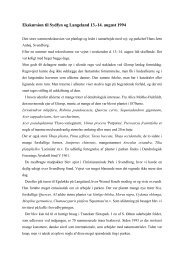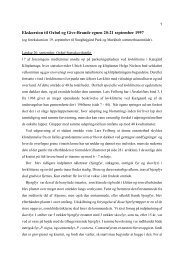Volume 6,3 (1987) - Dansk Dendrologisk Forening
Volume 6,3 (1987) - Dansk Dendrologisk Forening
Volume 6,3 (1987) - Dansk Dendrologisk Forening
Create successful ePaper yourself
Turn your PDF publications into a flip-book with our unique Google optimized e-Paper software.
SUMMARY<br />
Elliottia racemosa Ell.<br />
Discovered - Forgotten - Refound<br />
This is the story of the very rare Elliottia racemosa which is found only in<br />
a few localities in Georgia, U.S.A. After its discovery shortly before<br />
1817, the species seemed to have disappered until it was rediscovered<br />
in 1901. After a visit to Arnold Arboretum in 1977, director K.-E.<br />
Flinck donated a plant to the Botanical Gardens of Copenhagen. This<br />
plant was replanted in 1984 to a new Rhododendron bed, and in August/<br />
September 1985 it had 4 flowering racemes.<br />
The position of Elliottia in Ericaceae within the tribe Ledeae is discussed,<br />
considering characteristics such as free petals, loculicid capsule<br />
and very small broadwinged seeds.<br />
Elliottia racemosa was discovered by the botanist Stephen Elliott<br />
before 1817 in Burke Co, but it was soon regarded as a new genus by<br />
the amateur botanist dr. G.H. Muhlenberg, who named the plant after<br />
St. Elliott. However, it was St. Elliott who gave the first description in<br />
his own publication from 1817: Sketch of the Botany of St. Carolina and<br />
Georgia.<br />
Nothing further was heard about Elliottia until 1873, but a wellknown<br />
gardener P.J. Berkmans had found a stand 10 years earlier in<br />
the vicinity of the town Augusta, from where he had taken some shrubs<br />
for his garden. In 1894 he sent some rootsuckers from plants to Kew to<br />
be propagated. One plant survived and flowered in 1911. At the end of<br />
the 19th century Elliottia had disappeared from the previously known<br />
places, but in 1901 it was rediscovered in Bullock Co, E. Georgia and<br />
in Telfair and Coffee Co s. in S. Georgia. From the largest area, 5<br />
plants were sent to Kew in order to increase distribution within<br />
England. It is not known if the plant succeeded outside Kew. In the<br />
Arnold Arboretum however, work has been carried out on the propagation<br />
of Elliottia.<br />
A systematic survey of Elliottia is given, and special notice is taken of<br />
the racemes, each with 40-90 pure white, mildly scented flowers. The<br />
capsule and seeds were first described in 1936. The seedset is sparse,<br />
but a reasonable reproduction is seen in places. If the root is damaged<br />
suckers may occur.<br />
Relating to W.R. Knight's notes from 1937-38, an ecological description<br />
of the largest stands of Elliottia in Bullock Co is given in


